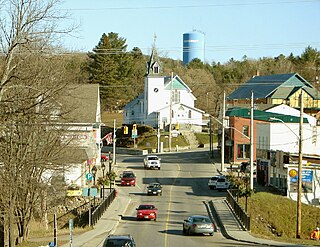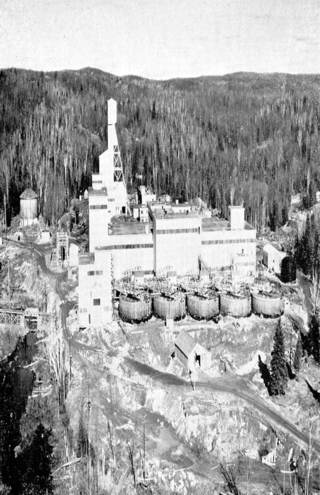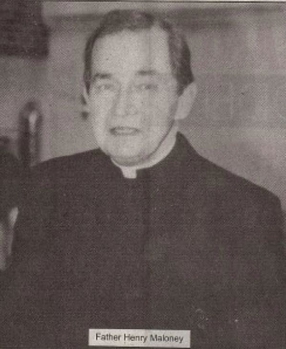Early life

Arthur Herbert Shore was born in Campbellford in 19 May 1893. [4] His parents were Arthur Shore B.1865 and Mary Margaret Emiline McNaughton 1865-1910. He was the middle child of five with 4 sisters. [5]
Arthur Herbert Shore | |
|---|---|
| Born | 19 May 1893 Campbellford, Ontario |
| Died | 10 July 1958 Burks Falls, Ontario |
| Nationality | Canadian |
| Occupation(s) | Farmer, Box maker, Dairy farmer, Prospector, Miner. |
| Known for | Uranium prospecting and mining |
Arthur Herbert Shore (born 19 May 1893) was a mineral prospector and the first person set up a uranium mine in Faraday Township, Ontario. [1] [2] He co-founded and managed the Reeves feldspar Mine and founded the Faraday Uranium Mine. [1] His uranium prospecting, according to Bayne in 1977, led to the "greatest uranium prospecting rush in the world." [3]

Arthur Herbert Shore was born in Campbellford in 19 May 1893. [4] His parents were Arthur Shore B.1865 and Mary Margaret Emiline McNaughton 1865-1910. He was the middle child of five with 4 sisters. [5]
Shore worked in Bancroft as a box maker, as a dairy worker, and as a miner in Cobalt, Ontario. [4]
From 1945 to 1946, Shore was the Managing Director of Bancroft Feldspar Mines Limited, the company that owned and operated Reeves Mine. [6]
In partnership with Roy Munnings, they mined 1,190 tons of feldspar [6] from the mine, which was located at lot 6, Concession XII of Monteagle Township, just north of Bancroft. [7] Shore employed four workers at the mine. [6] After unsuccessfully prospecting many locations nearby Bancroft, and after taking advice from Toronto geologist John C. B. Rogers, [8] in 1948 or 1949, Shore discovered uranium at a lot in Faraday Township. The exact location was lot 15, concession A, a mile from Highway 28, 5 miles south of Bancroft. [1] [3] [9] [10] [2]
Shore used adjacent lots 16 and 17 of Concession 10 to developed a mine. [1]
After buying up the property on surrounding lots, on 22 June 1949, Shore incorporated Faraday Uranium Mines Limited, and appointed himself as president. [1] [11]
Shore attempted to raise funds to develop the property, but was initially unsuccessful as potential investors were discouraged the perception that the geology in Bancroft was incompatible with the economical extraction of uranium. [12]
Shore dug trenches and stripped rock himself, employing geologists and engineers when needed, before seriously injuring himself. [1]
In 1952, Shore received financial support from Toronto-based Newkirk Mining Corporation and work was done by Pole Star Mining. [1] [12]
Shore sold control of the company to Augustus Exploration Limited, who started full development of the site in 1952. [11]

Shore, along with fellow prospectors Bob Thompson and Russ McDonell staked prospects on York River Uranium Mines near Bancroft, in October 1955. [13] Shore discovered uranium mineralization at the Eagle Nest Occurrence, 1.3 km northeast of Bancroft, in 1956. [14] The same year, Shore held shares in Burma Shores Mines Limited, a company incorporated in Toronto that had mineral rights in the plots adjacent to Faraday Mine, in Cardiff, Ontario. [15] [16] [17] The company was dissolved in April 1965. [17]
In the early 1950's Shore opened a Motel in Bancroft, Ontario. It closed in the late 1950's due to going bankrupt. Shore retired to Trout Creek Nursing Home in Burks Falls after finding out he had cancer. He passed away 10 July 1958. [5]
Godfrey is a small community located about 40 minutes' drive time north of Kingston, Ontario, Canada on Hwy. 38. It is named for Chester H. Godfrey, one of the original settlers, who donated land on which the village was built. While there is currently no specific village, it can be described as the area of Highway 38 that extends between the villages of Verona and Parham, as well as that portion of Westport Road extending to the hamlet of Burridge. It also includes the former settlement of Cole Lake.. Godfrey was originally in the Township of Hinchinbrooke which has since become amalgamated into the township of Central Frontenac, which also encompasses the townships of Kennebec, Olden and Oso.

Bancroft is a town located on the York River in Hastings County in the Canadian province of Ontario. It was first settled in the 1850s by United Empire Loyalists and Irish immigrants. From the mid-1950s to about 1982, mining was the primary industry. A village until 1999, Bancroft then merged with Dungannon Township to form the Town of Bancroft. The population at the time of the 2016 Census was 3,881; the regional population is 40,000. There are 150,000 visitors to Bancroft, annually.
Gilbert A. LaBine, was a Canadian prospector who, in 1930, discovered radium and uranium deposits at Port Radium, Northwest Territories. He has become known as the father of Canada's uranium industry. LaBine was president of Eldorado Gold Mines from its start in the late 1920s to 1947. He left the company, which had become a Crown corporation in 1944, to prospect for uranium minerals as an independent mine developer. In the 1950s he brought the Gunnar Mine to production at Uranium City, Saskatchewan.

The Eldorado Mine is a defunct mine located in Port Radium, Northwest Territories, Canada. The site, which covers 12 hectares, is located next to Echo Bay in the shore of Great Bear Lake.

Madawaska Mine (previously known as Faraday Mine) is a decommissioned underground uranium mine in Faraday, near the town of Bancroft, Ontario, which produced 9 million pounds (4,082 tonnes) of U3O8 concentrate, at an average ore grade of 0.1074%, during its two periods of production.

Faraday is a township in the Canadian province of Ontario, located within Hastings County adjacent to the town of Bancroft.
The Pronto Mine is an historical uranium mine located approximately 20 km south of Elliot Lake, Ontario near Spragge. The site is owned and operated by Rio Algom Ltd, has been rehabilitated and is currently undergoing environmental monitoring.

Canada is the world's second-largest producer of uranium, behind Kazakhstan. In 2009, 20% of the world's primary uranium production came from mines in Canada. 14.5% of the world production came from one mine, McArthur River. Currently, the only producing area in Canada is northern Saskatchewan, although other areas have had active mines in the past.
The Agnew Lake Mine was a uranium mine located in the township of Hyman approximately 10 kilometres (6.2 mi) northeast of Agnew Lake, Ontario and 75 kilometres (47 mi) east of Elliot Lake, Ontario.

Bicroft Mine is a decommissioned underground uranium mine, located in Cardiff, near Bancroft, Ontario, Canada.

Dyno Mine is a decommissioned underground uranium mine located at Cardiff, near Farrel Lake, approximately 30km southwest of Bancroft, Ontario. It operated from 1958 to 1960.

Greyhawk Mine is a decommissioned underground uranium mine located in Faraday Township near Bancroft, Ontario. It operated from 1954 to 1959 and from 1976 to 1982. The mine produced 80,247 tons of uranium ore, of which 0.069% was U3O8 worth $834,899.

Uranium mining around Bancroft, Ontario, was conducted at four sites, beginning in the early 1950s and concluding by 1982. Bancroft was one of two major uranium-producing areas in Ontario, and one of seven in Canada, all located along the edge of the Canadian Shield. In the context of mining, the "Bancroft area" includes Haliburton, Hastings, and Renfrew counties, and all areas between Minden and Lake Clear. Activity in the mid-1950s was described by engineer A. S. Bayne in a 1977 report as the "greatest uranium prospecting rush in the world".

Henry Joseph Maloney was a Canadian priest, a school and college governor, and community leader based in Bancroft, Ontario.

Kerr Addison Mines Ltd was a Toronto-based mining and gas company that owned various mines throughout Canada, including the Agnew Lake Mine, the Kerr-Addison Mine and Chesterville gold mine.

Uranium mining in the Elliot Lake area represents one of two major uranium-producing areas in Ontario, and one of seven in Canada.
Silver Crater Mine, previously known as the Basin Deposit, is an abandoned mine in Cardiff, Ontario. It has produced some of the world's most notable betafite crystals.
The Fission Mine, previously known as the Richardson Deposit, is a fluoride and uranium deposit in Cardiff, near Wilberforce, Ontario, Canada.

Cardiff is a community in Highlands East, Ontario. It was incorporated in 1862, and became a uranium mining town during the late 1950s.
{{cite book}}: CS1 maint: multiple names: authors list (link){{citation}}: CS1 maint: others (link)